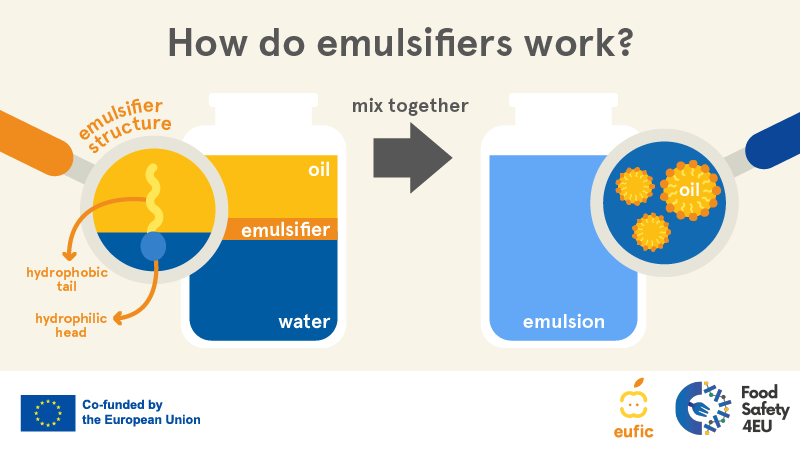Emulsifier In Food Truth vs. Fiction You Should Know
All About the Duty of an Emulsifier in Food and Its Significance in Modern Cuisine
Emulsifiers are pivotal in modern food, assisting in the mix of immiscible liquids like oil and water. Their capability to maintain mixtures boosts the structure and taste of different foodstuff. From salad dressings to baked goods, emulsifiers play a substantial function in both industrial and home food preparation. The science behind their function and the future technologies in their use remain less explored. What more could be discovered regarding these crucial culinary representatives?
Recognizing Emulsification: The Science Behind the Process
Although emulsification may appear like a straightforward cooking strategy, it entails complicated clinical principles that are vital for creating steady mixes of immiscible liquids, such as oil and water. At the heart of this process exists the principle of surface area tension, which protects against both fluids from blending naturally. Emulsifiers, compounds that lower surface tension, play a crucial duty in promoting the mix of these fluids. They possess both hydrophilic (water-attracting) and hydrophobic (water-repelling) homes, enabling them to secure themselves at the user interface in between oil and water.
When an emulsifier is presented and the combination is perturbed, it creates a safety barrier around dispersed beads of one liquid within the other, stabilizing the combination. This action not only improves structure and mouthfeel in food items but additionally adds to their aesthetic allure. Emulsifier In Food. Comprehending the science behind emulsification is basic in modern food, permitting cooks to develop a variety of sauces, dressings, and emulsified dishes
Typical Kinds Of Emulsifiers Used in Food
Emulsifiers are vital components in the food sector, playing an important function in stabilizing combinations of oil and water. Various sorts of emulsifiers are typically used, each with unique buildings fit for different applications. Lecithin, stemmed from soybeans or egg yolks, is among one of the most popular natural emulsifiers, often discovered in dressings and chocolates. Mono- and diglycerides, which are originated from glycerol and fats, are commonly used in baked goods and margarine to boost appearance and expand life span. Another usual emulsifier is polysorbate 80, preferred for its capacity to boost the uniformity of gelato and sauces. Furthermore, xanthan gum and guar gum tissue serve as thickening representatives that additionally add to emulsification in gluten-free items. These emulsifiers are indispensable to creating a secure, palatable product in modern-day food solutions, making sure a pleasant sensory experience for customers.
The Duty of Emulsifiers in Numerous Food Products
A range of food rely upon emulsifiers to achieve preferred appearances and stability. These substances promote the mixing of immiscible fluids, such as oil and water, which is essential in many refined foods. For instance, in salad dressings, emulsifiers aid preserve a consistent blend, avoiding splitting up and improving shelf life. In baked goods, they contribute to a consistent crumb framework and wetness retention, enhancing general high quality.
Emulsifiers also play a significant function in milk items, such as gelato and yogurt, where they maintain fat blobs, guaranteeing a smooth mouthfeel. Furthermore, in sauces and condiments, they boost thickness and enhance spreadability. This functionality is vital in the production of chocolates, margarine, and mayonnaise, where a cohesive product is essential. Overall, the use of emulsifiers in various food is integral to contemporary food manufacturing, enhancing stability and consistency across a wide variety of products.
Exactly How Emulsifiers Enhance Texture and Flavor

When integrated into food, emulsifiers significantly enhance both appearance and taste, creating a more satisfying eating experience. These compounds assist in the mixing of components that normally do not mix well, such as oil and water, leading to a smoother, creamier uniformity. This not only boosts mouthfeel but likewise allows flavors to spread uniformly throughout the product, enhancing the overall taste.

Emulsifiers in Home Cooking: Tips and Techniques
Exactly how can home cooks successfully make use of emulsifiers to boost their recipes? Emulsifiers play an essential function in attaining preferable appearances and tastes in homemade dishes. As an example, utilizing egg yolks in mayo or hollandaise sauce enables a stable emulsion, integrating oil and water properly. Home cooks can likewise experiment with mustard, which acts as an emulsifier in vinaigrettes, making sure a smooth uniformity.
In cooking, integrating lecithin, discovered in egg yolks or soy, can enhance dough stability and moisture retention. Additionally, making use of business emulsifiers like xanthan gum or guar periodontal can assist thicken sauces and dressings while maintaining a velvety mouthfeel.
When producing gelato or whipped garnishes, emulsifiers can stop ice crystal formation, resulting in More about the author a smoother texture. By mastering these methods, home cooks can considerably raise their culinary productions, offering pleasurable and regular dishes that display the power of emulsification.
The Future of Emulsifiers in Culinary Technology
As the culinary globe continues to evolve, the role of emulsifiers is positioned to end up being progressively ingenious and diverse. Advances in food scientific research are causing the growth of brand-new emulsifying agents stemmed from natural sources, which deal with health-conscious consumers and boost the sensory top qualities of meals. Developments such as plant-based emulsifiers are gaining grip, allowing cooks to produce vegan and allergen-free options without jeopardizing appearance or taste.
Additionally, using emulsifiers in molecular gastronomy is broadening, making it possible for chefs to explore one-of-a-kind textures and presentations that astound diners. As sustainability ends up being a priority, the future might see a shift in the direction of environment-friendly emulsifiers that reduce ecological effect.
Eventually, emulsifiers will certainly proceed to play a crucial duty in culinary development, connecting the space in between tradition and modernity, and enabling cooks to push the boundaries of creative thinking in their kitchens.
Often Asked Inquiries

Are Emulsifiers Safe for Individuals With Allergies?
Emulsifiers can be secure for people with allergies, depending on their specific sensitivities. However, specific emulsifiers, obtained from allergenic sources like soy or eggs, may activate reactions, demanding careful component scrutiny and consultation with health care experts.
Just How Do Emulsifiers Impact Food Service Life?
Emulsifiers improve food service life by maintaining blends, avoiding splitting up, and minimizing microbial growth. This security helps preserve appearance and flavor over time, permitting items to remain risk-free and enticing for intake much longer than without emulsifiers.
Can Emulsifiers Be Derived From Natural Resources?
Yes, emulsifiers can be acquired from natural resources such as plants, eggs, and dairy items (Emulsifier In Food). These natural emulsifiers assist stabilize mixtures, boosting texture and uniformity in various food applications while being preferred for health-conscious consumers
What Are the Ecological Influences of Emulsifier Manufacturing?
The ecological influences of emulsifier production consist of resource deficiency, environment devastation, and pollution from synthetic processes. All-natural emulsifier sourcing can reduce some results, however on the whole, industrial my blog practices still posture substantial environmental difficulties to communities worldwide.

Are There Vegan Emulsifiers Available in the Market?
Yes, there are numerous vegan emulsifiers offered in the marketplace, such as lecithin stemmed from soy or sunflower, guar periodontal, and xanthan gum. These alternatives deal with plant-based diet regimens without jeopardizing emulsifying buildings.
Emulsifiers are crucial ingredients in the food market, playing an essential role in stabilizing mixes of oil and water. A variety of food products count on emulsifiers to accomplish preferred appearances and security. When incorporated right into food products, emulsifiers significantly improve both structure and flavor, developing a more delightful eating experience. Additionally, emulsifiers can support visit this website air pockets in whipped products like lotions and mousses, leading to a light and ventilated texture. Emulsifiers improve food shelf life by maintaining blends, preventing splitting up, and decreasing microbial development.